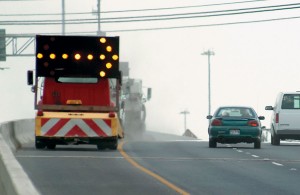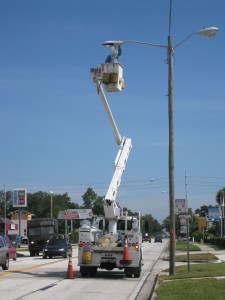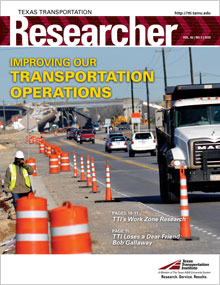
Traffic operations, such as improving the safety and efficiency of work zones, are coast-to-coast priorities. Texas Transportation Institute (TTI) researchers journey outside the Lone Star State whenever — and wherever — duty calls. Three recent work zone projects have been part of TTI‘s effort to help sponsors nationwide.
Intrusion Countermeasures
Orange-and-white drums do not always prevent motorists from veering into a highway work zone area. These dangerous driving situations, called intrusions, caught the attention of the California Department of Transportation (Caltrans). So when Caltrans decided to evaluate strategies and devices other than barriers to reduce intrusions, TTI‘s Jerry Ullman took the wheel.
“The common belief is that all intrusions are caused by the driver losing control and veering into the work zone,” says Jerry Ullman, senior research engineer. “But the research shows a lot of intrusion problems are the result of deliberate driver disregard for traffic control.”
Jerry Ullman’s team researched the chain of events that lead to intrusions and brainstormed countermeasures that could be used to alter those chains, such as closer spacing of drums, placing barricades crosswise more frequently in closed lanes, and providing law enforcement presence upstream and within the work zone. The project, now in its final stages, will provide guidance for which countermeasures should be used under certain roadway conditions and the cost-effectiveness of each.
Improving Road Restriping Safety
One emerging technology for work zones and incident traffic control is the truck-mounted changeable message sign (TMCMS). These signs provide drivers with information on upcoming problems and actions to take. They are smaller than typical changeable message signs and have less character space and character height but are mobile.
A few states, such as Wyoming and Texas, have begun using TMCMSs, but there is limited research on how to establish effective messages for the smaller-format signs during active work operations. The Wyoming Department of Transportation (WYDOT) wanted to use TMCMSs for striping projects but needed guidance on applicable situations and appropriate messages. So WYDOT teamed up with TTI‘s Brooke Ullman, an expert on changeable message signs.
“The key is not to overload drivers. Drivers have limited time to read, comprehend and react to TMCMS messages. The message must be concise but get the point across,” says Brooke Ullman, assistant research engineer. “TMCMSs are great technology when used effectively.”
Brooke Ullman’s team surveyed WYDOT field personnel to identify the main hazards associated with mobile operations and potential ways the TMCMS could be used to help mitigate those hazards. After assessing driver reaction to several of the more promising messages, the researchers recommended TMCMS message sets for mobile operations for WYDOT to consider.
“Mike Gostovich, state traffic engineer for WYDOT (now retired), told me he is amazed with the depth and usefulness of the information provided by TTI in the report. Mike asked me to send copies of the report to each of our transportation districts, and each district is now budgeting funds to purchase at least one, and perhaps more, truck-mounted changeable message signs,” says Michael Patritch, research manager at WYDOT. “From project completion to implementation, the results of the study can be measured in mere days.”
Utility Operations Merging Taper Length

Conditions such as lighting, sight distance, traffic volume and speed all factor into the effectiveness and risk associated with temporary traffic control for utility work. Research on merging taper lengths — the practice of using cones to slowly merge two lanes of traffic into one — has been very limited.
Utility companies in Florida, in order to follow federal guidelines on merging taper lengths, sometimes spend 30 minutes to set up cones to spend 5 minutes changing a light bulb. This time inefficiency led the Florida Department of Transportation (FDOT) to call TTI for research on using shorter merging taper lengths for short work duration activities, while also minimizing risk to the worker and motorist.
“As engineers, we can’t lose sight of the fact that we have to balance both the workers’ safety and the safety of the motoring public. We can’t leave the worker exposed without visual cues for the motorist, but on the other hand, we could endanger the motorist by leaving something in the lane,” says LuAnn Theiss, an associate research engineer with TTI.
Theiss’s team recommends that operations that last more than 15 minutes should utilize merging taper lengths that meet federal requirements. However, for utility crew operations lasting 15 minutes or less, the large bucket truck and flashing lights appear to provide sufficient cues to drivers.
“We were very glad to have the TTI team do this research for us,” says Jim Mills, a roadway design engineer with FDOT. “It was much-needed research that hasn’t been addressed anywhere. More research is needed, but it certainly provided us with information that will be used to improve our work zone standards.”
